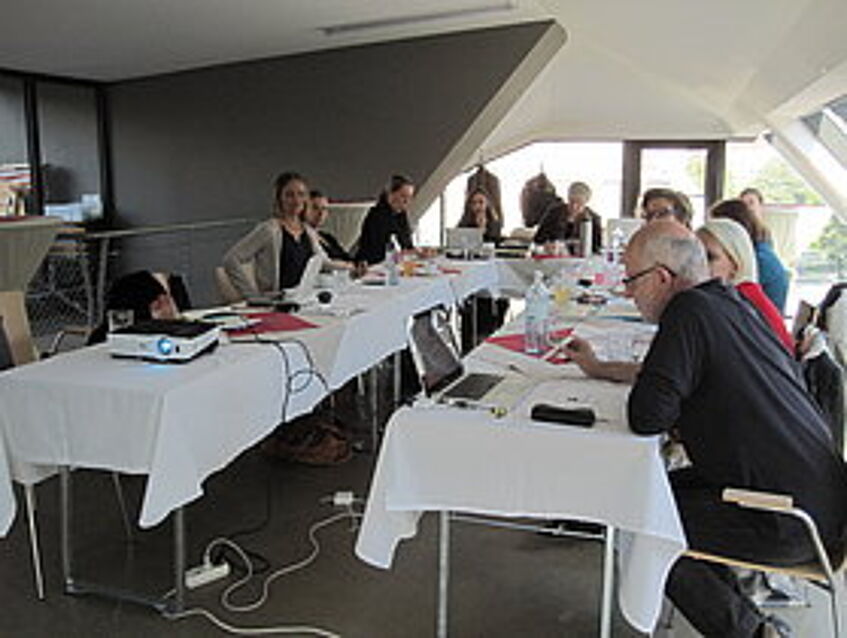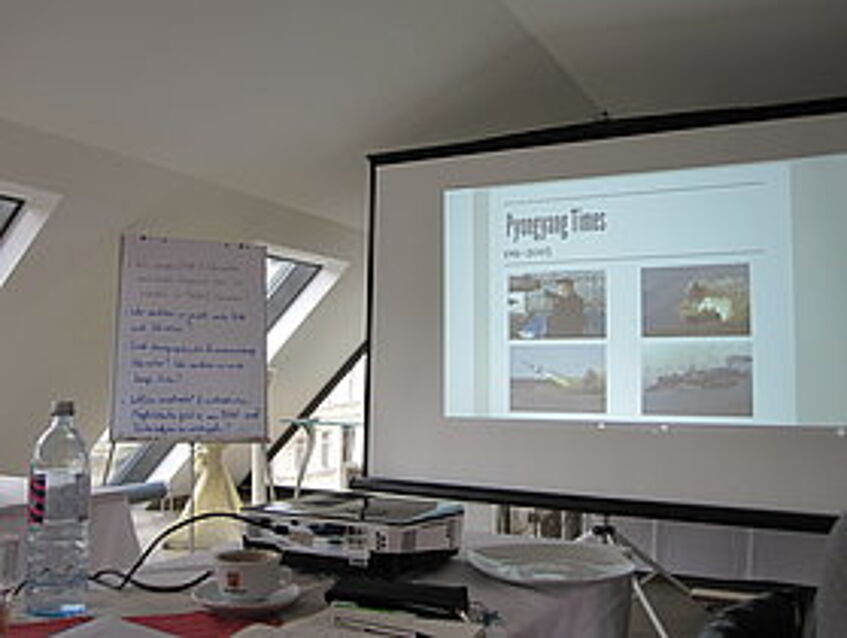Workshop "Image and Narration"

Discussions at the roof-top atelier "mittendrin"

Dijana Matanovic's presentation on Political Storytelling
On September 29 2015, the research area Visual Studies in the Social Sciences hosted a one-day workshop on the complex relationships between images and narrations. Seven researchers from the Faculty of Social Sciences at the Universiy of Vienna came together to explore this topic from the different disciplinary angles of Sociology, Media Studies and Political Science. The aim of the workshop was to further advance the interdisciplinary dialogue between visual researchers at the Faculty of Social Sciences and to discuss ways in which images and texts work together to create meaning not encompassed by discrete modes.
Petra Bernhardt (Political Science) started with a presentation on Hillary Clinton’s presidential campaign kickoff. Based on a visual frame analysis of Clinton's Facebook feed, Bernhardt showed how photographs support notions of approachability, likability and down-to-earthness as central ideas of Clinton’s brand narrative. Bernhardt suggested that an iconographic analysis of conventionalized photographic motives could inform qualitative research on digital political storytelling and help to shed light on underlying strategies and implicit meanings of visual political communication.
Andreas Pribersky (Political Science) talked about political icons as central tools of political reasoning in the Early Modern period. Pribersky introduced the motive of the “good government” (buon governo) and showed how it travelled through time and space in order to transform into a contemporary allegory of the republic.
Dijana Matanovic (Political Science) talked about The Political Storytelling of Kim Jong Un. Based on an analysis of press coverage in two North Korean newspapers — Pyongyang Times (aimed at an international audience) and Rodong Sinmun (aimed at a North Korean audience) — Matanovic introduced the motive of “on-spot guidance” as decisive for North Korean leadership representation. Photos of “site visits” of Kim Jong Un support the image of the all-knowing leader. Matanovic argued that the selection of photographs for different news outlets and the supporting texts promote different messages for audiences at home and abroad (e.g. security of the North Korean people vs. defence for an external audience).
Roswitha Breckner (Sociology) addressed the difference between image and narration from a biographical perspective. Breckner raised the question if Facebook feeds can be seen and analysed as biographic constructions. Based on a specific visual and narration-based methodology (segment analysis), Breckner argued that life histories become visible, even though they were not intentionally performed as life stories.
Maria Schreiber (Media Studies) presented Empirical Approaches to Pictorial Practices on Smartphones. Drawing on different datasets (images, screenshots, interviews), Schreiber discussed generation-specific practices of “showing and sharing” of smartphone pictures among teenagers and elderly people and highlighted the inter-connection between personal photographs, technology (smartphone and software) and the habitual knowledge of the individual.
Maria Pohn-Lauggas (Sociology) talked about the role of photographs for biographic narrations. Based on a set of interviews with families of resistance fighters against the Nazi regime, Pohn-Lauggas showed how family narratives can influence biographic constructions and the interpretation of family photographs over generations.
Eva Flicker (Sociology) introduced the method of Viscourse analysis to talk about official photographs of political summits (e.g., G7, G8, G20, European Union). Flicker examined how official political representations perpetuate prevailing gender representations and the manifestation of global inequalities.
The workshop presentations contributed to an understanding of relationships between images, texts and narratives in various ways. The participants agreed that overarching definitions of “images” and “text” are neither necessary nor useful to promote an interdisciplinary dialogue. Instead, researchers should start with a clarification of their positions based on their specific methodological backgrounds in order to reveal the context-specific ways of interconnectedness and juxtaposition of images and narrations.
Workshop Programme
Location: roof-top atelier "mittendrin" (Währinger Straße 19, 1090 Vienna)
9.30 Welcome and introduction (Maria Schreiber, Maria Pohn-Lauggas, Roswitha Breckner)
9.45–10.30 Image & Narration in Hillary Clinton’s campaign kickoff rally | Petra Bernhardt
10.30–11.15 Models of relations between image and narration in the Early Modern period | Andreas Pribersky
11.15–11.30 Coffee break
11.30–12.15 The Political Storytelling of Kim Jong Un | Dijana Matanovic
12.15–13.15 Lunch break
13.15–14.00 Narratives and visual communication on Facebook. A biographical research perspective | Roswitha Breckner
14.00–14.45 Image vs./and/or Interview? Empirical Approaches to Pictorial Practices on Smartphones | Maria Schreiber
14.45–15.15 Coffee break
15.15–16.00 Biographical narrations and photo collections | Maria Pohn-Lauggas
16.00–16.45 Viscourse Analysis of Power/Politics/Gender | Eva Flicker
16.45–17.45 Summary and Feedback
